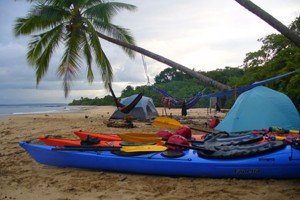
(ctpost.com) It reminded us of the opening scene of “Fantasy Island.”
As soon as our boat arrived at the Cala Mia dock on the island of Boca Brava, Panama, two hotel workers welcomed us to the property. No, they weren’t Mr. Roarke and Tattoo, but we were somewhere in the Pacific Ocean.
During this, our second visit to Panama, we decided we would try to do what every tourist promoter of the isthmus boasts — enjoy breakfast on the Pacific and lunch on the Caribbean. Or see the sunrise on the Caribbean and the sunset on the Pacific.
The biggest problem with planning this trip was deciding where to go. There are many options on both sides of Panama, but it’s not easy to travel between the destinations, as most domestic flights must go through Panama City.
On the Pacific, you can visit Isla Coiba, the Gulf of Chiriqui or Islas Perlas. The crystal clear waters of the Caribbean can be enjoyed in Bocas del Toro or San Blas. We decided to hit the two Bocas — Boca Brava, an island in the Gulf of Chiriqui, and Bocas del Toro, an archipelago in the Caribbean.
We started our vacation by renting a car at the airport in the city of David. We spent a few days near Volcan Baru National Park, where we hiked and saw a variety of birds. We never spotted the famous Quetzal, but we saw plenty of hummingbirds during our walks through the forests, where we also never encountered any other hikers.
While in the Chiriqui province, we also visited the remote Finca Hartmann, a coffee plantation, and the Finca Dracula, an orchid plantation named for a rare orchid and because the now-deceased founder also enjoyed Dracula flicks.
But the main goal of our trip was relaxing on the beach. So after two nights in the mountains, we headed for Boca Brava, a tiny fishing village a one-hour drive southeast of David. We parked our rental car on the street and took a boat to the remote island of Boca Brava, passing one lush spit of land after another over 20 minutes.
We visited Panama in June, during its rainy season, when there are fewer tourists than usual.
On our first night at Cala Mia, a boutique hotel with just 11 thatched-roof bungalows, only one other yellow-and-peach bungalow was occupied. On our second night, my husband and I were the only guests to enjoy the hotel’s Italian-inspired meals, made with ingredients from its farm and dairy, and the only people soaking in the infinity pool with its views of the Gulf of Chiriqui. I had fantasies of renting the entire hotel for a weekend-long party for friends and relatives.
The bungalow cost us $225 plus tax per night, and that included three delicious meals each day. Delicious salads and sandwiches were options for lunch. Each day, we were asked which special we wanted for dinner, such as lobster or fish.
During most of our time, we relaxed on the beach or on our patio overlooking the sea. We did spend one morning kayaking through the nearby mangroves, spying a turtle along the way.
Although we never saw one, howler monkeys hanging out in the nearby forest awakened us every morning.
The only things I wish we had done differently were pack bug spray and spend another night on the island.
Once back in Boca Chica, we drove along the Inter-American Highway to the town of Chiriqui, where Panama’s Fortuna Road begins. We saw beautiful vistas, the Fortuna Dam and cloud forests. The road winds through the Fortuna Forest Reserve, where drivers must pay a $3 entrance fee at the park station before continuing on to Almirante.
About four hours after leaving Boca Chica, we arrived in the industrial port city of Almirante. Young boys rushed out to greet us and tell us where to park our rental car, for tips, of course. We paid a hefty fee for picking up the car in one city and leaving it in this un-touristy town, but we enjoyed the freedom of visiting all the sites on our list.
Our young tour guides hauled our luggage to the nearby water taxi dock, where we were charged $5 for the journey to Bocas del Toro, the hub of activity in the region.
Twenty minutes later, we were in the tourist town, eating lunch at a Thai restaurant overlooking the Caribbean. The town is quite international, with Indian, Chinese and Caribbean restaurants and popular with both European and American tourists. It’s also the spot to book diving trips, go to bars, stock up on groceries and visit the region’s only ATM.
After lunch, we boarded another water taxi for the island of Bastimentos.
We rented a private house, but there are many options in the area for travelers — from hostels for backpackers to luxury lodging.
In Bastimentos, we hiked, swam and enjoyed the island’s zipline tour. And we saw several of the island’s most famous residents — the tiny red frogs. An island tour guide paddled us through the mangroves in his cayuco, a traditional Panamanian canoe made out of a tree trunk, pointing out more than a dozen sloths and parrots, among other wildlife.
Panama pushers were right. You can have it all in one day in Panama — the Caribbean and the Pacific.